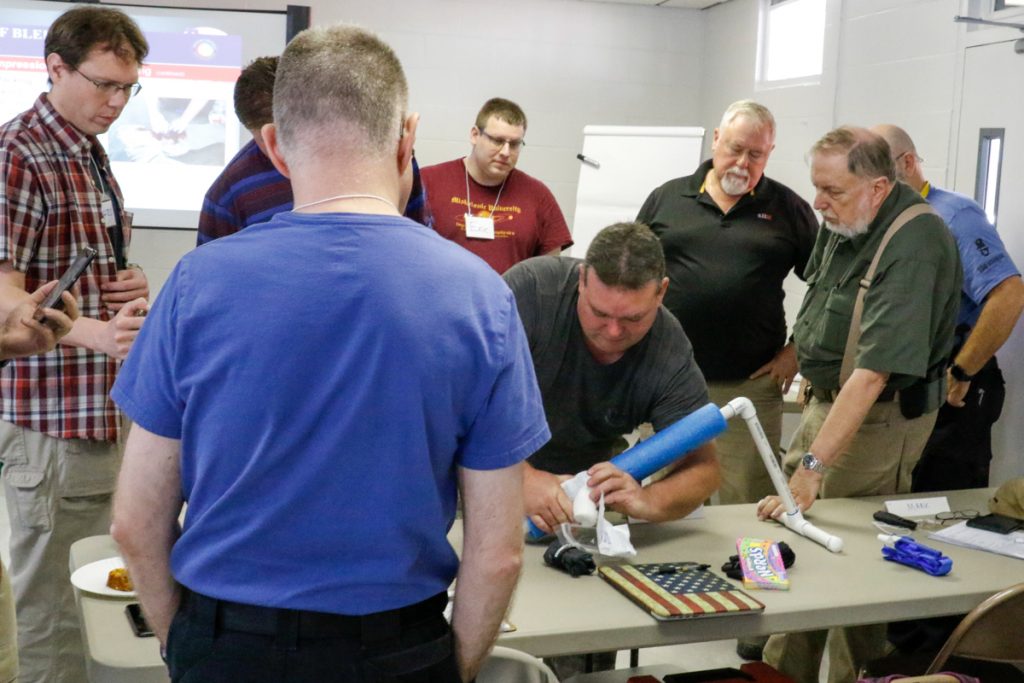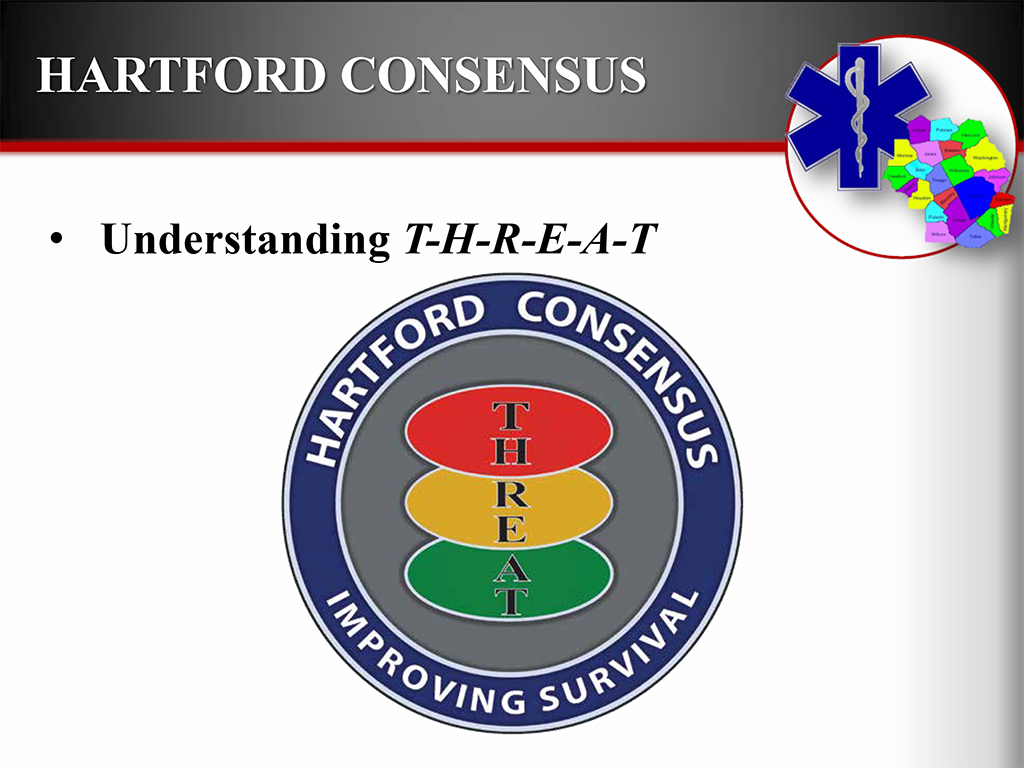I’ve saved for last the course that was presented first at the MAG reunion: a full Stop The Bleed™ class, with certification, taught by veteran paramedic and paramedic instructor Stacy Kitchens. In some ways, it was the most important. A SWAT medic among other duties, Stacy is one of our regular adjunct staff people and has extensive experience in the field treatment of gunshot wounds and other life-threatening trauma.

We keep a full trauma kit on the range with us at all times, including an automatic electronic defibrillator. I remember the gentleman who “dropped dead” at a shooting match I attended in while still in my teens. Nothing like that was available for ordinary folks acting as first responders then. He didn’t make it.
And it ain’t just for the range: we keep all the same gear in the car. The Evil Princess, a retired RN, generally has her tourniquet/field dressing/Quickclot™ on her person in an ankle rig. We carry guns in case we have to deal with someone trying to kill us or another innocent party. Even if we prevail against him, he may have already harmed at least one victim. The emergency medical service is hampered by the same laws of time and space as the police service, and often, the citizen on the ground where it happens is the only one who’ll have a chance to save a fading life…if that citizen is both trained and equipped to deal with the problem.
And of course, it’s not limited to combat situations. Even in recreational shooting, we have to remember that we’re handling dangerous equipment. Accidents happen. The injuries are similar, however they may be inflicted.
And it’s not limited to guns, either. The one time I had to give CPR was in a big city train station. If you are in a rural area, remote from emergency medical service, ask yourself how often you and yours are exposed to major trauma. Accidental impairment. A slip of the ax or the chainsaw. A bite, kick, or goring inflicted by livestock or even family pets and working animals. The principles are the same.
When any of these things happen, we may be the victim, and alone. Stacy Kitchens paid particular attention to self-application of the tourniquet and everything else.
Stacy is a great instructor. As I recall, the critiques by the attendees gave him full “tens” across the board. His knowledge is something everyone reading this needs.



I am 63 years old, and I need a CPR rig at my range. Mitchell Ota
Mitchell, I haven’t seen you since you used to come down to Chester NH Rod & Gun to shoot pins with us
Great advice!!
I have attended two Stop The Bleed courses in Nashville TN taught by Vanderbilt physicians. The second I had requested be run at our church. They are invaluable. I carry a blowout kit in my car and occasionally were a small one on my ankle.
Be prepared!
As always, another great column! In 2019, I signed up for and successfully completed a Red Cross First Aid and CPR class (adult and child) just to have the basic knowledge should it ever become necessary to employ it. I think that every concerned citizen, whether pro-2A or not, should have the basic FA/CPR skill set because you never know when it might be necessary. I plan to keep up with my certification every 2 years.
Also, that leads me to ask you, Mas, or The Evil Princess, what you would recommend for a realistic first aid kit that could be kept on one’s person for EDC? Would it be a commercially-purchased kit or one that would be put together from individually-purchased components? Obviously, one on a belt is going to be much more abbreviated than one for home or an automobile. Thank you in advance!
Everyone should know first aid. Back in 2012 I remember Joe Fox talking about prepping on YouTube. He said he knew a lot of people who were stocking up on guns and ammo. He said they needed to stock up on bandages if they thought there would be a lot of shooting going on. He was a Green Beret.
I keep some Israeli Battle dressings in the car and in the bag that is always where I am.
I never travel weapon less or without my bride of 43 years on the job as an RN she’s saved my life twice.
As a former paramedic and now as a physician working in a very rural hospital I wear a “ Parabelt” which is designed by a former SF medic to be used as a ratcheting TQ. AEDs are in the hospital but mostly stopping bad bleeds is what saves lives in trauma like a shooting or knifing, or the other accidents Mas mentioned. Everything else can wait or isn’t salvageable by most people. I also carry needle to decompress tension pneumothorax. Of course bandaids are much more likely to be needed so having a few nearby is good. Otherwise carrying a full IFAK on your ankle is t overly useful. Save the life then deal with the nuisance stuff later.
My certifications for basic first aid and CPR obtained while working as a LEO has expired ages ago, but I still remember most of the stuff taught and have several well stocked first aid kits equipped with trauma bandages and blood clotting sponges and gauze. Each of my vehicles has a kit and I have a smaller one in my carry bag. The home kit is the most extensive and contained in two metal boxes. Since my late father was a MD, he had surgical tools and other doctor stuff which I inherited, and I have enough equipment to perform operations such as amputating arms, legs, or heads – if needed. Recon Medical sells the Israeli trauma bandages which are good items to have for gunshot wounds and I also have small blood clotting band-aids and powder for less serious injuries. Of course wearing a ballistic vest at night and during the cooler months helps a lot. Having one on at all times would be idea, but not very practical for people not wearing a badge and uniform.
My last Patrol Rifle Instructor course had a section on stopping the bleed (we had an experienced combat medic in the class). For those without specialized training, the Combat Gauze type products are much better than the original Quick Clot granulated stuff. When I got back home, checking with the EMT honchos indicated that the state didn’t approve use of the original Quick Clot as few stateside medical facilities were trained on it.
Obviously the EP is trained. The rest of us……….
Also out of that class section, sanitary napkins & tampons do very well on stopping bleeding. You probably have some of those around. If you get TQs, practice with them. While someone is bleeding is no time to be learning, and some need to be pre-staged to apply with one hand if it’s you with a problem.
Here’s an article (out of many from a Google search) that do NOT recommend tampons for stopping life threatening hemorrhage. My wife and a close friend of ours both are MD’s and do special operations medicine for the military – they agree that tampons are not for control of bleeding due to penetrating trauma – they do not provide the pressure needed to stop bleeding. My wife allowed they can be useful for bad nose bleeds.
See this article for more information – https://www.crisis-medicine.com/heavy-flow-is-not-massive-hemorrhage-tampons-dont-belong-in-ifaks/
Had to give CPR on a man at a sporting clays shoot. It was exhausting the ambulance arrived within
15 minutes but it was to late, massive heart attack. He had previous history.
Be prepared !!
Comments are closed.